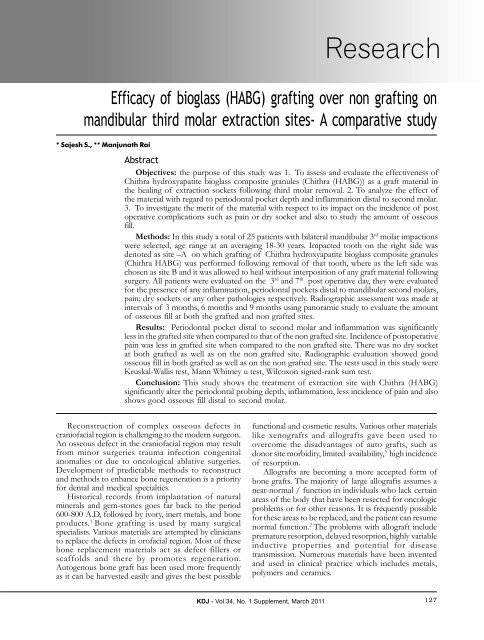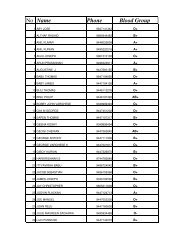Vol 34 No 2 suppli final.pmd - IDA KERALA STATE ::. idakerala.com
Vol 34 No 2 suppli final.pmd - IDA KERALA STATE ::. idakerala.com
Vol 34 No 2 suppli final.pmd - IDA KERALA STATE ::. idakerala.com
Create successful ePaper yourself
Turn your PDF publications into a flip-book with our unique Google optimized e-Paper software.
Efficacy of bioglass (HABG) grafting over non grafting on<br />
mandibular third molar extraction sites- A <strong>com</strong>parative study<br />
* Sajesh S., ** Manjunath Rai<br />
Reconstruction of <strong>com</strong>plex osseous defects in<br />
craniofacial region is challenging to the modern surgeon.<br />
An osseous defect in the craniofacial region may result<br />
from minor surgeries trauma infection congenital<br />
anomalies or due to oncological ablative surgeries.<br />
Development of predictable methods to reconstruct<br />
and methods to enhance bone regeneration is a priority<br />
for dental and medical specialties.<br />
Historical records from implantation of natural<br />
minerals and gem-stones goes far back to the period<br />
600-800 A.D, followed by ivory, inert metals, and bone<br />
products. 1 Bone grafting is used by many surgical<br />
specialists. Various materials are attempted by clinicians<br />
to replace the defects in orofacial region. Most of these<br />
bone replacement materials act as defect fillers or<br />
scaffolds and there by promotes regeneration.<br />
Autogenous bone graft has been used more frequently<br />
as it can be harvested easily and gives the best possible<br />
KDJ - <strong>Vol</strong>.<strong>34</strong>, <strong>No</strong>. 1 Supplement, March 2011<br />
Research<br />
Abstract<br />
Objectives: the purpose of this study was 1. To assess and evaluate the effectiveness of<br />
Chithra hydroxyapatite bioglass <strong>com</strong>posite granules (Chithra (HABG)) as a graft material in<br />
the healing of extraction sockets following third molar removal. 2. To analyze the effect of<br />
the material with regard to periodontal pocket depth and inflammation distal to second molar.<br />
3. To investigate the merit of the material with respect to its impact on the incidence of post<br />
operative <strong>com</strong>plications such as pain or dry socket and also to study the amount of osseous<br />
fill.<br />
Methods: In this study a total of 25 patients with bilateral mandibular 3 rd molar impactions<br />
were selected, age range at an averaging 18-30 years. Impacted tooth on the right side was<br />
denoted as site –A on which grafting of Chithra hydroxyapatite bioglass <strong>com</strong>posite granules<br />
(Chithra HABG) was performed following removal of that tooth, where as the left side was<br />
chosen as site B and it was allowed to heal without interposition of any graft material following<br />
surgery. All patients were evaluated on the 3 rd and 7 th post operative day, they were evaluated<br />
for the presence of any inflammation, periodontal pockets distal to mandibular second molars,<br />
pain; dry sockets or any other pathologies respectively. Radiographic assessment was made at<br />
intervals of 3 months, 6 months and 9 months using panoramic study to evaluate the amount<br />
of osseous fill at both the grafted and non grafted sites.<br />
Results: Periodontal pocket distal to second molar and inflammation was significantly<br />
less in the grafted site when <strong>com</strong>pared to that of the non grafted site. Incidence of postoperative<br />
pain was less in grafted site when <strong>com</strong>pared to the non grafted site. There was no dry socket<br />
at both grafted as well as on the non grafted site. Radiographic evaluation showed good<br />
osseous fill in both grafted as well as on the non grafted site. The tests used in this study were<br />
Kruskal-Wallis test, Mann Whitney u test, Wilcoxon signed-rank sum test.<br />
Conclusion: This study shows the treatment of extraction site with Chithra (HABG)<br />
significantly alter the periodontal probing depth, inflammation, less incidence of pain and also<br />
shows good osseous fill distal to second molar.<br />
functional and cosmetic results. Various other materials<br />
like xenografts and allografts gave been used to<br />
over<strong>com</strong>e the disadvantages of auto grafts, such as<br />
donor site morbidity, limited availability, 3 high incidence<br />
of resorption.<br />
Allografts are be<strong>com</strong>ing a more accepted form of<br />
bone grafts. The majority of large allografts assumes a<br />
near-normal / function in individuals who lack certain<br />
areas of the body that have been resected for oncologic<br />
problems or for other reasons. It is frequently possible<br />
for these areas to be replaced, and the patient can resume<br />
normal function. 2 The problems with allograft include<br />
premature resorption, delayed resorption, highly variable<br />
inductive properties and potential for disease<br />
transmission. Numerous materials have been invented<br />
and used in clinical practice which includes metals,<br />
polymers and ceramics.<br />
127




